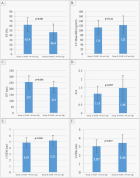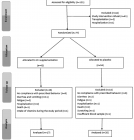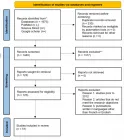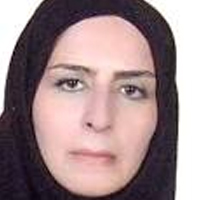Abstract
Review Article
Herbal approach for obesity management
Preeti Singh*
Published: 30 November, 2018 | Volume 2 - Issue 1 | Pages: 005-016
Heftiness, a mind boggling interchange among ecological and hereditary factors and is related with critical horribleness and mortality. Utilization of herbs for the administration of heftiness in the ongoing occasions is pulling in consideration. A web and manual based writing overview was led to survey the measure of data accessible on the natural items for weight administration. Customary writing, PubMed, Scopus, Google researcher databases were screened up to February 2012. The pursuit words were “stoutness”, “home grown medication/items/separates”, “restorative plants”, “customary drug”, “Ayurvedic prescription” without narrowing/constraining looking words or components. Distributions just with edited compositions/full articles and books were inspected in the pursuit. In light of the accessible writing, for huge numbers of the natural and weight reduction items, there is minimal distributed data and there have been no clinical preliminaries or the level of proof is restricted. Our writing study additionally demonstrated that these home grown items fall under an adequate level of proof or with no scientific foundation by any stretch of the imagination, or they have a logical discerning however not to an acknowledgment level. Endeavors were made in the audit to characterize the highlights of conceivable natural weight reduction item. A perfect home grown enemy of stoutness item ought to diminish the weight by 10% over fake treatment of treatment by demonstrating a proof of change of bio markers like blood pres-beyond any doubt, lipids and glycemia with no reactions.
Read Full Article HTML DOI: 10.29328/journal.niogb.1001008 Cite this Article Read Full Article PDF
Keywords:
Morbidity; Ayurveda; Obesity; Literature survey; Medicinal plants; Herbal products; Weight management
References
- World Health Organization. Obesity. Preventing and Managing the Global Epidemic, Report of a WHO Con- sultation (WHO Technical Report Series 894). WHO. 2000; Ref.: https://goo.gl/mRUXnQ
- Worldwide Obesity Trends—Globesity. Ref.: https://goo.gl/WTa5P1
- Centre for Public Health Excellence at NICE (UK), Na-tional Collaborating Centre for Primary Care (UK) Obesity: The Prevention, Identification, Assessment and Management of Overweight and Obesity in Adults and Children. National Institute for Health and Clinical Ex-cellence (UK) (NICE Clinical Guidelines: 43), 2006; Ref.: https://goo.gl/19FCLw
- Obesity and Overweight. Fact Sheet No. 311, 2012; Ref.: https://goo.gl/F4qjF5
- Scheen J. From Obesity to Diabetes: Why, When and Who? Acta Clinica Belgica. (2002; 55: 9- 15. Ref.: https://goo.gl/UN6UZv
- Felber JP, Golay A. Pathways from Obesity to Diabetes. Int J Obes Relat Metab Disord. 2002; 26: 39-45. Ref.: https://goo.gl/YNwmSS
- Bhatti GR, Qureshi R, Shah SM. Ethnobotany of Calotropis procera with Especial Reference to the People of Nara Desert. Scientific Sindh. 1990; 5: 13-22. Ref.: https://goo.gl/NqPJyy
- Rahman U, Zaman K. Medicinal Plants with Hypo- glycemic Activity. J Ethnopharmacol. 1989; 2: 1-55. Ref.: https://goo.gl/UeXnb1
- Food and Drug Administration. FDA Briefing Document NDA 21-888 Zimulti (rimonabant) Tablets, 20 mg Sanofi Aventis Advisory Committee. 2007; 2007. Ref.: https://goo.gl/VawXvi
- Cooke D, Bloom S. The Obesity Pipeline: Current Strategies in the Development of Anti-Obesity Drugs. Nature Reviews Drug Discovery. 2006; 5: 919-931. Ref.: https://goo.gl/bSzCpr
- Pinder RM, Brogden RN, Sawyer PR, Speight TM, Avery GS. Fenfluramine: A Review of Its Phar- macological Properties and Therapeutic Efficacy in Obesity. Drugs. 1975; 10: 4: 241-323. Ref.: https://goo.gl/M2DQaR
- Brenot, P. Herve, P. Petitpretz, F. Parent, Duroux P, Simonneau G. Primary Pulmonary Hypertension and Fenfluramine Use. Br Heart J. 1993; 70: 537-541. Ref.: https://goo.gl/sdQeUP
- Connolly HM, Crary JL, McGoon MD, Hensrud DD, Edwards BS, et al. Valvular Heart Disease Associated with Fenfluramine- Phentermine. N Engl J Med. 1997; 337: 581-588. Ref.: https://goo.gl/XhprfD
- Swinburn BA, Caterson I, Seidell JC, James WP. Diet, Nutrition and the Prevention of Excess Weight Gain and Obesity. Public Health Nutr. 2004; 7: 123-146. Ref.: https://goo.gl/43KcH9
- Park JP, Kim JH, Park MK, Yun JW. Potential Agents for Cancer and Obesity Treatment with Herbal Medicines from the Green Garden. Biotechnology and Bioprocess Engineering. 2011; 16: 1065- 1076. Ref.: https://goo.gl/wMLdFJ
- Amin KA, Nagy MA. Effect of Carnitine and Herbal Mixture Extract on Obesity Induced by High Fat Diet in Rats. Diabetology & Metabolic Syndrome. 2009; 1: 1-14. Ref.: https://goo.gl/yZnzqn
- Pickering RP, Grant BF, Chou SP, Compton WM. Are Overweight, Obesity, and Extreme Obe- sity Associated with Psychopathology? Results from the National Epidemiologic Survey on Alcohol and Related Conditions. J Clin Psychiatry. 2007; 68: 998-1009. Ref.: https://goo.gl/SZDXSS
- Dickerson FB, Brown CH, Kreyenbuhl JA, Fang L, Goldberg RW, et al. Obesity among Individuals with Serious Mental Illness. Acta Psychiatrica Scandinavica. 26; 113: 306- 313. Ref.: https://goo.gl/Ns9A1e
- Simon GE, Von Korff M, Saunders K, Miglioretti DL, Crane PK, et al. Association between Obesity and Psychiatric Disorders in the US Adult Population. Arch Gen Psychiatry. 2006; 63: 824-830. Ref.: https://goo.gl/FqDKiB
- Aronne LJ. Classification of Obesity and Assessment of Obesity-Related Health Risks. Obesity Research. 2002; 10: 105-115. Ref.: https://goo.gl/z2vGDf
- Ayensa JI, Calderon MJ. Psychopathological Comorbidity in Obesity. An Sist Sanit Navar. 2011; 34: 253-261. Ref.: https://goo.gl/3EpBgP
- Britz B, Siegfried W, Ziegler A, Lamertz C, Herpertz-Dahlmann BM, et al. Rates of Psychiatric Disorders in a Clinical Study Group of Adolescents with Extreme Obesity and in Obese Adolescents Ascertained via a Population Based Study. Int J Obes Relat Metab Disord. 2000; 24: 1707-1714. Ref.: https://goo.gl/oYqnLp
- Lee J, Chae K, Ha J, Park BY, Lee HS, et al. Regulation of Obesity and Lipid Disorders by Herbal Extracts from Morus alba, Melissa officinalis, and Artemisia capillaries in high-fat Diet-Induced Obese Mice. J Ethnopharmacol. 2008; 115: 263-270. Ref.: https://goo.gl/sS1GkG
- Gosh D. A Botanical Approach to Managing Obesity. University of Wollongong, Wollongong.2009; Ref.: https://goo.gl/mmAqj3
- Sharma PV. Dravya Guna Vijnana. Chaukhambha Bharati Academy, Varanasi 1993;.
- Sharma PC, Yelne MB, Dennis TJ, Joshi A. Database on Medicinal Plants Used in Ayurveda. Central Council for Research in Ayurveda and Siddha, India. 2000; Ref.: https://goo.gl/LK3eME
- Gogte VM. Medicinal Plants, Part III in Ayurvedic Pharmacology and Therapeutic Uses of Medicinal Plants (Dravyagunavignyan). Bhartiya Vidya Bhavan, Mumbai. 2002; Ref.: https://goo.gl/jy2XZi
- Misra, Vaisya R. Bhavaprakasha Nigantu. Chau-kamba Sanskrit Sansthan, Varanasi. 2005;
- Yun JW. Possible Anti-Obesity Therapeutics from Nature A Review. Phytochemistry. 2010; 71: 1625-1641. Ref.: https://goo.gl/k4TAMa
- Saper RB, Eisenberg DM, Phillips RS. Common Dietary Supplements for Weight Loss. Am Fam Physician. 2004; 70: 1731- 1738. Ref.: https://goo.gl/Ey9G7A
- Ioannides-Demos LL, Piccenna L, McNeil JJ. Pharmacotherapies for Obesity: Past, Current, and Future Therapies. J Obes. 2011; Article ID: 179674. Ref.: https://goo.gl/fJHvcV
- Birari RB, Bhutani KK. Pancreatic Lipase Inhibitors from Natural Sources: Unexplored Potential. Drug Discov Today. 2007; 12: 879-889. Ref.: https://goo.gl/4XBnU9
- Tsujita T, Takaichi H, Takaku T, Aoyama S, Hiraki J. Antiobesity Action of E-Polylysine, a Potent In- hibitor of Pancreatic Lipase. J Lipid Res. 2006; 47: 1852-1858. Ref.: https://goo.gl/8n6P7L
- Han LK, Zheng YN, Yoshikawa M, Okuda H, Kimura Y. Anti-Obesity Effects of Chikusetsusaponins Isolated from Panax japonicus Rhizome. BMC Complement Altern Med. 2005; 5: 9. Ref.: https://goo.gl/TcTLJ1
- Han LK, Xu BJ, Kimura Y, Zheng Yn, Okuda H. Platycodiradix Affects Lipid Metabolism in Mice with High Fat Diet-Induced Obesity. J Nutr. 2000; 130: 2760-2764. Ref.: https://goo.gl/u8xNDX
- Kishino E, Ito T, Fujita K, Kiuchi Y. A Mixture of the Salacia reticulata (Kotala Himbutu) Aqueous Extract and Cyclodextrin Reduces the Accumulation of Visceral Fat Mass in Mice and Rats with High-Fat Diet-Induced Obesity. J Nutr. 2006; 136: 433-439. Ref.: https://goo.gl/8HPtNs
- Ono Y, Hattori E, Fukaya Y, Imai S, Ohizumi Y. Anti-Obesity Effect of Nelumbo nucifera Leaf Extract in Mice and Rats. J Ethnopharmacol. 2006; 106: 238-244. Ref.: https://goo.gl/ksWRUK
- Kim HY, Kang MH. Screening of Korean Medicinal Plants for Lipase Inhibitory Activity. Send to Phytother Res. 2005; 19: 359-361. Ref.: https://goo.gl/U5DuUK
- A. Moreno, N. Ilic, A. Poulev and I. Raskin. Effects of Arachis hypogaea Nutshell Extract on Lipid Metabolic Enzymes and Obesity Parameters. Life Sci. 2006; 78: 2797-2803. Ref.: https://goo.gl/bydeMM
- Shimoda H, Seki K, Aitani M. Inhibitory Effect of Green Coffee Bean Extract on Fat Accumulation and Body Weight Gain in Mice. BMC Complement Altern Med. 2006; 6: 1-9. Ref.: https://goo.gl/zFsfjS
- Han LK, Takaku T, Li J, Kimura Y, Okuda H. Anti-Obesity Action of Oolong Tea. Int J Obes Relat Metab Disord. 1999; 23: 98-105. Ref.: https://goo.gl/AEmtKR
- Nakai M, Fukui Y, Asami S, Toyoda-Ono Y, Iwashita T, et al. Inhibitory Effects of Oolong Tea Polyphenols on Pancreatic Lipase in Vitro. J Agric Food Chem. 2005; 53: 4593-4598. Ref.: https://goo.gl/msrSBV
- Thielecke F, Boschmann M. The Potential Role of Green Tea Catechins in the Prevention of the Metabolic Syndrome—A Review. Phytochemistry. 209; 70: 11-24. Ref.: https://goo.gl/D1hDPL
- Kim HK, Della-Fera M, Lin J, Baile CA. Docosahexaenoic Acid Inhibits Adipocyte Differentiation and Induces Apoptosis in 3T3-L1 Preadipocytes. J Nutr. 2006; 136: 2965-2969. Ref.: https://goo.gl/XA44Kv
- Spiegelman BM, Hu E, Kim JB, Brun R. PPAR Gamma and the Control of Adipogenesis. Biochimistry. 1997; 79: 111-112. Ref.: https://goo.gl/pmaEMo
- Lombardo YB, Chicco AG. Effects of Dietary Polyunsaturated n-3 Fatty Acids on Dyslipidemia and Insulin Resistance in Rodents and Humans. A Review. J Nutr Biochem. 2006; 17: 1-13. Ref.: https://goo.gl/r8WgY9
- Murase T, Nagasawa A, Suzuki J, Hase T, Tokimitsu I. Beneficial Effects of Tea Catechins on Diet-Induced Obesity: Stimulation of Lipid Catabolism in the Liver. Int J Obes Relat Metab Disord. 1999; 26: 1459- 1464. Ref.: https://goo.gl/r9jRjp
- Kao YH, Hiipakka RA, Liao S. Modulation of Endocrine Systems and Food Intake by Green Tea Epigallocatechin Gallate. Endocrinology. 2000; 141: 980-987. Ref.: https://goo.gl/jaavYv
- Sayama K, Lin S, Zheng G, Oguni I. Effects of Green Tea on Growth, Food Utilization and Lipid Metabolism in Mice. In Vivo. 2000; 14: 481- 484. Ref.: https://goo.gl/sdMPQJ
- Chien PJ, Chen YC, Lu SC, Sheu F. Dietary Flavonoids Suppress Adipogenesis in 3T3-L1 Preadipocytes. Journal of Food and Drug Analysis. 2005 13: 168-175. Ref.: https://goo.gl/9T3Sm7
- Hargrave KM, Li C, Meyer BJ, Kachman SD, Hartzell DL. Adipose Depletion and Apoptosis Induced by Trans-10, Cis-12 Conjugated Linoleic Acid in Mice. Obes Res. 2002; 10: 1284-1290. Ref.: https://goo.gl/ao4QGr
- Hwang JT, Park IJ, Shin JI, Lee YK, Lee SK, et al. Genistein, EGCG, and Capsaicin Inhibit Adipocyte Differentiation Process via Activating AMP-Activated Protein Kinase. Biochem Biophys Res Commun. 2002; 338: 694-699. Ref.: https://goo.gl/tr9X1b
- Hsu CL, Yen GC. Induction of Cell Apoptosis in 3T3-L1 Pre-Adipocytes by Flavonoids Is Associated with Their Antioxidant Activity. Mol Nutr Food Res. 2006; 50: 1072-1079. Ref.: https://goo.gl/Un2F5G
- Yang JY, Della-Fera MA, Hartzell DL, Nelson-Dooley C, Hausman DB, et al. Esculetin Induces Apoptosis and Inhibits Adipogenesis in 3T3-L1 Cells. Obesity. 2006; 14: 1691-1699. Ref.: https://goo.gl/TBfBUA
- Yang JY, Della-Fera MA, Rayalam S, Ambati S, Hartzell DL, et al. Enhanced Inhibition of Adipogenesis and Induction of Apoptosis in 3T3- L1 Adipocytes with Combinations of Resveratrol and Quercetin. 2008; Life Sci. 82: 1032-1039. Ref.: https://goo.gl/8g1r1b
- Picard F, Kurtev M, Chung N, Topark-Ngarm A, Senawong T, et al. Sirt1 Promotes Fat Mobilization in White Adipocytes by Repressing PPAR-Gamma. Nature. 2004; 429: 771-776. Ref.: https://goo.gl/mrU4Hx
- Rayalam S, Della-Fera MA, Baile CA. Phytochemicals and Regulation of the Adipocyte Life Cycle. The Journal of Nutritional Biochemistry. 2008; 19: 717-726. Ref.: https://goo.gl/eZsJc8
- Flatt JP. Differences in basal energy expenditure and obesity. Obesity. 2007; 15: 2546-2548. Ref.: https://goo.gl/2XzLHm
- Redinger RN. Fat Storage and the Biology of Energy Expenditure. Transl Res. 2009; 154: 52-60. Ref.: https://goo.gl/EkS28a
- Cannon B, Nedergaard J. Brown Adipose Tissue: Function and Physiological Significance. Physiol Rev. 2004; 84: 277-359. Ref.: https://goo.gl/nopuxu
- Kumar MV, Sunvold GD, Scarpace PJ. Dietary Vitamin a Supplementation in Rats: Suppression of Leptin and Induction of UCP1 mRNA. J Lipid Res. 1999; 40: 824-829. Ref.: https://goo.gl/L6dCMZ
- Yoon SS, Rhee YH, Lee HJ, Lee EO, Lee MH. Uncoupled Protein 3 and p38 Signal Pathways Are Involved in Anti-Obesity Activity of Solanum tuberosum L. cv. Bora Valley. J Ethnopharmacol. 2008; 118: 396-404. Ref.: https://goo.gl/RCeqkf
- Dulloo AG. Ephedrine, Xanthines and Prostaglandin-Inhibitors: Actions and Interactions in the Stimulation of Thermogenesis. Int J Obes Relat Metab Disord. 1993; 17: 35-40. Ref.: https://goo.gl/BEHun7
- Racotta IS, Leblanc J, Richard D. The Effect of Caffeine on Food Intake in Rats: Involvement of Corticotropin Releasing Factor and the Sympatho-Adrenal System. Pharmacol Biochem Behav. 1994; 48: 887-892. Ref.: https://goo.gl/zKSU3T
- Kawada T, Watanabe T, Takaishi T, Tanaka T, Iwai K. Capsaicin-Induced Beta-Adrenergic Action on Energy Metabolism in Rats: Influence of Capsaicin on Oxy-gen Consumption, the Respiratory Quotient, and Substrate Utilization. Proc Soc Exp Biol Med. 1986; 183: 250-256. Ref.: https://goo.gl/NtGwh6
- Langin D. Adipose Tissue Lipolysis as a Metabolic Pathway to Define Pharmacological Strategies against Obesity and the Metabolic Syndrome. Pharmacol Res. 2006; 53: 482-491. Ref.: https://goo.gl/zDvENb
- Ohkoshi E, Miyazaki H, Shindo K, Watanabe H, Yoshida A, et al. Constituents from the Leaf of Nelumbo nucifera Stimulate Lipolysis in the White Adipose Tissue of Mice. Planta Medica. 2007; 73: 1255-1259. Ref.: https://goo.gl/Hofn4m
- Flier JS. Obesity Wars: Molecular Progress Confronts an Expanding Epidemic. Cell. 2004; 116: 337-350. Ref.: https://goo.gl/EVv9WY
- Morton GJ, Cummings DE, Baskin DG, Barsh GS, Schwartz MW. Central Nervous System Control of Food Intake and Body Weight. Nature. 2006; 443: 289-295. Ref.: https://goo.gl/gaN2uX
- Di Pierro F, Menghi AB, Barreca A, Lucarelli M, Calandrelli A. Greenselect Phytosome as an Adjunct to a Low-Calorie Diet for Treatment of Obesity: A Clinical Trial. Altern Med Rev. 2009; 14: 154-160. Ref.: https://goo.gl/xTY4co
- Kim SO, Yun SJ, Jung B, Lee EH, Hahm DH, et al. Hypolipidemic Effects of Crude Ex- tract of Adlay Seed (Coix lachrymajobi var. Mayuen) in Obesity Rat Fed High Fat Diet: Relations of TNF-Alpha and Leptin mRNA Expressions and Serum Lipid Levels. Life Sci. 2004; 75: 1391-1404. Ref.: https://goo.gl/9BdNp2
- Weigle DS. Pharmacological Therapy of Obesity: Past, Present, and Future. The Journal of Clinical Endocrinology and Metabolism. 2003; 88: 2462- 2469. Ref.: https://goo.gl/wuZX99
- Tecott LH, Sun LM, Akana SF, Strack AM, Lowenstein DH, et al. Eating Disorder and Epilepsy in Mice Lacking 5-HT2c Serotonin Receptors. Nature. 1995; 374: 542-546. Ref.: https://goo.gl/UvMceL
- Halford JC, Blundell JE. Pharmacology of Appetite Suppression. Prog Drug Res. 2000; 54: 25-58. Ref.: https://goo.gl/B5VCPF
- Wynne K, Stanley S, McGowan B, Bloom S. Appetite Control. J Endocrinol. 2005; 184: 291-318. Ref.: https://goo.gl/QguvQJ
- Wolfram S, Wang Y, Thielecke F. Anti-Obesity Effects of Green Tea: From Bedside to Bench. Mol Nutr Food Res. 2006; 50: 176-187. Ref.: https://goo.gl/axTBAV
- Moon HS, Lee HG, Choi YJ, Kim TG, Cho CS. Proposed Mechanisms of (–)-Epigallocatechin-3- Gallate for Anti-Obesity. Chemico Biological Interactions. 2007; 167: 85-98. Ref.: https://goo.gl/GR7rbX
- Borchardt RT, Huber JA. Catechol O-methyl- transferase. 5. Structure—Activity Relationships for Inhibition by Flavonoids. J Med Chem. 1975; 18: 120-122. Ref.: https://goo.gl/CUgfiJ
- Boschmann M, Thielecke F. The Effects of Epigallocatechin-3-Gallate on Thermogenesis and Fat Oxidation in Obese Men: A Pilot Study. J Am Coll Nutr. 2007; 26: 389-395. Ref.: https://goo.gl/iSyMdW
Similar Articles
-
The interaction between photonic technology and physical exercise: The action of low-level laser therapyAntonio Eduardo de Aquino Jr*,Fernanda Mansano Carbinatto. The interaction between photonic technology and physical exercise: The action of low-level laser therapy. . 2017 doi: 10.29328/journal.hodms.1001003; 1: 010-013
-
Behavioral factors of Abdominal Obesity and effects of lifestyle changes with Fiber AdequacyRoberto Carlos Burini*,Hugo Tadashi Kano,Mariana Santoro Nakagaki,Patricia Baston Frenhani,Katia Cristina Portero-McLellan. Behavioral factors of Abdominal Obesity and effects of lifestyle changes with Fiber Adequacy. . 2017 doi: 10.29328/journal.hodms.1001004; 1: 014-022
-
Upper gut bacterial overgrowth is a potential mechanism for Glucose Malabsorption after Vertical Sleeve GastrectomyTimothy R Koch*,Timothy R Shope,Matthew E Sharbaugh. Upper gut bacterial overgrowth is a potential mechanism for Glucose Malabsorption after Vertical Sleeve Gastrectomy. . 2017 doi: 10.29328/journal.hodms.1001006; 1: 030-035
-
Body mass index in a group of security forces (policemen). Cross-sectional studyGuillermo Padrón Arredondo*. Body mass index in a group of security forces (policemen). Cross-sectional study. . 2018 doi: 10.29328/journal.niogb.1001007; 2: 001-004
-
Herbal approach for obesity managementPreeti Singh*. Herbal approach for obesity management. . 2018 doi: 10.29328/journal.niogb.1001008; 2: 005-016
-
Dietary and Lifestyles assessment among Obese Women in Gaza City, PalestineMarwan O Jalambo*,Basil Kanoa,Mohammed S Ellulu,Smaher Younis,Mueen El-Kariri. Dietary and Lifestyles assessment among Obese Women in Gaza City, Palestine. . 2018 doi: 10.29328/journal.niogb.1001009; 2: 017-025
-
Obesity-Treatment by drugsSahithi G*. Obesity-Treatment by drugs. . 2019 doi: 10.29328/journal.niogb.1001010; 3: 001-001
-
ECHO…for a change!!Manish Motwani*,Rajeev Palvia,Bhavesh Nanda,Mahek Motwani,Bhakti Chaubal,Jyoti Kesarkar, Bhakti Mange,Sneha Shukla. ECHO…for a change!!. . 2020 doi: 10.29328/journal.niogb.1001011; 4: 001-003
-
Neuroticism and BMI: The role of genetic tendency, behavior and environment on body weightMolly Jacobs*. Neuroticism and BMI: The role of genetic tendency, behavior and environment on body weight. . 2020 doi: 10.29328/journal.niogb.1001012; 4: 004-012
-
The review of the relationship between UCP2 and obesity: Focusing on inflammatory-obesityMohamadreza Alivand*,Beitullah Alipour*,Sara Moradi,Yaser Khaje-Bishak,Maedeh Alipour. The review of the relationship between UCP2 and obesity: Focusing on inflammatory-obesity. . 2021 doi: 10.29328/journal.niogb.1001015; 5: 001-013
Recently Viewed
-
Misoprostol Usage in the Kingdom of Bahrain: A Retrospective StudyMaryam Alsalem*,Hosni Malas,Gulmeen Raza,Rehab Ismael. Misoprostol Usage in the Kingdom of Bahrain: A Retrospective Study. Clin J Obstet Gynecol. 2025: doi: 10.29328/journal.cjog.1001196; 8: 092-095
-
Treatment Options for Congenital Dyserythropoietic Anemias (CDAs): Advances in Bone Marrow Transplantation, Gene Therapy, and Targeted TherapiesSophia Delicou*,Maria Moraki,Elena Papatheodorou,Aikaterini Xydaki. Treatment Options for Congenital Dyserythropoietic Anemias (CDAs): Advances in Bone Marrow Transplantation, Gene Therapy, and Targeted Therapies. J Hematol Clin Res. 2024: doi: 10.29328/journal.jhcr.1001031; 8: 027-033
-
Stability Duration of a Normal Control Pool for Prothrombin Time and Activated Partial Thromboplastin Time Prepared in the Hematology and Blood Bank Service of the Yaoundé University Teaching Hospital, CameroonMokou Claude Bertrand,Juste Patient Mbebi Enone,Toche Fotso Paul Senclaire,Koguep Ngongang Astride,Ngo Etoah Marie Claire,Makuete Lonkeng Alvine,Eyoum Bille Bertrand*,Tayou Tagny Claude. Stability Duration of a Normal Control Pool for Prothrombin Time and Activated Partial Thromboplastin Time Prepared in the Hematology and Blood Bank Service of the Yaoundé University Teaching Hospital, Cameroon. J Hematol Clin Res. 2025: doi: 10.29328/journal.jhcr.1001038; 9: 027-034
-
Coronaviruses have reached at Pre-elimination Stage with Nine Amino Acid Spike Deletions and Forty-nine Nucleotide 3’-UTR DeletionsAsit Kumar Chakraborty*. Coronaviruses have reached at Pre-elimination Stage with Nine Amino Acid Spike Deletions and Forty-nine Nucleotide 3’-UTR Deletions. Int J Clin Virol. 2024: doi: 10.29328/journal.ijcv.1001060; 8: 031-044
-
Feasibility study of magnetic sensing for detecting single-neuron action potentialsDenis Tonini,Kai Wu,Renata Saha,Jian-Ping Wang*. Feasibility study of magnetic sensing for detecting single-neuron action potentials. Ann Biomed Sci Eng. 2022: doi: 10.29328/journal.abse.1001018; 6: 019-029
Most Viewed
-
Feasibility study of magnetic sensing for detecting single-neuron action potentialsDenis Tonini,Kai Wu,Renata Saha,Jian-Ping Wang*. Feasibility study of magnetic sensing for detecting single-neuron action potentials. Ann Biomed Sci Eng. 2022 doi: 10.29328/journal.abse.1001018; 6: 019-029
-
Evaluation of In vitro and Ex vivo Models for Studying the Effectiveness of Vaginal Drug Systems in Controlling Microbe Infections: A Systematic ReviewMohammad Hossein Karami*, Majid Abdouss*, Mandana Karami. Evaluation of In vitro and Ex vivo Models for Studying the Effectiveness of Vaginal Drug Systems in Controlling Microbe Infections: A Systematic Review. Clin J Obstet Gynecol. 2023 doi: 10.29328/journal.cjog.1001151; 6: 201-215
-
Causal Link between Human Blood Metabolites and Asthma: An Investigation Using Mendelian RandomizationYong-Qing Zhu, Xiao-Yan Meng, Jing-Hua Yang*. Causal Link between Human Blood Metabolites and Asthma: An Investigation Using Mendelian Randomization. Arch Asthma Allergy Immunol. 2023 doi: 10.29328/journal.aaai.1001032; 7: 012-022
-
Impact of Latex Sensitization on Asthma and Rhinitis Progression: A Study at Abidjan-Cocody University Hospital - Côte d’Ivoire (Progression of Asthma and Rhinitis related to Latex Sensitization)Dasse Sery Romuald*, KL Siransy, N Koffi, RO Yeboah, EK Nguessan, HA Adou, VP Goran-Kouacou, AU Assi, JY Seri, S Moussa, D Oura, CL Memel, H Koya, E Atoukoula. Impact of Latex Sensitization on Asthma and Rhinitis Progression: A Study at Abidjan-Cocody University Hospital - Côte d’Ivoire (Progression of Asthma and Rhinitis related to Latex Sensitization). Arch Asthma Allergy Immunol. 2024 doi: 10.29328/journal.aaai.1001035; 8: 007-012
-
An algorithm to safely manage oral food challenge in an office-based setting for children with multiple food allergiesNathalie Cottel,Aïcha Dieme,Véronique Orcel,Yannick Chantran,Mélisande Bourgoin-Heck,Jocelyne Just. An algorithm to safely manage oral food challenge in an office-based setting for children with multiple food allergies. Arch Asthma Allergy Immunol. 2021 doi: 10.29328/journal.aaai.1001027; 5: 030-037

If you are already a member of our network and need to keep track of any developments regarding a question you have already submitted, click "take me to my Query."

















































































































































